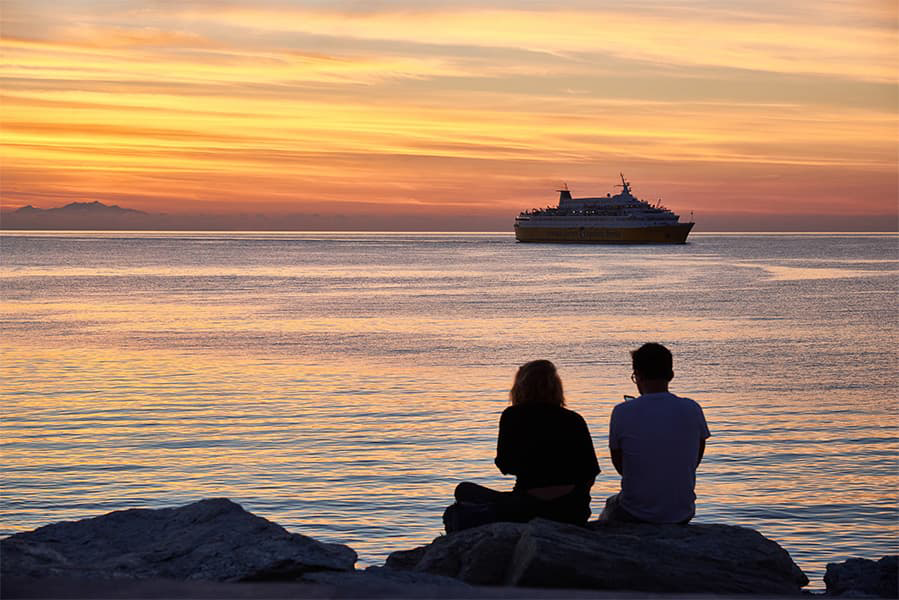Ferries from
Iceland to Faroe Islands
Ferries from
Iceland to Faroe Islands


Currently there are no sailings from Iceland to Faroe Islands.
There are no sailings from Iceland to Faroe Islands right now. Please visit our Deal Finder for alternative routes.
More routes than anyone else.

Compare fares, times & routes in one place.
Change plans easily with flexi tickets.

Book e-tickets & manage trips in-app.
Live ship tracking & real-time updates.

Top-rated customer support when you need it.
Iceland is a Nordic country and the most sparsely populated in Europe. Covering an area of just under forty thousand square miles between the Arctic and North Atlantic oceans, Iceland is home to just three hundred and twenty five thousand people. Iceland is volcanically active with many geological marvels - the northern lights, geysers and mountains, lava fields, glacial rivers that flow down to the sea and hot springs that supply much of the country’s heating. By ferry you can travel from Hirtshals in Denmark and Torshavn in the Faroe Islands to Seydisfjordur in Iceland with the Faroese ferry company Smyril Line. The ferry sails once a week between April and October and gives you the option to take your own vehicle or alternatively to travel on foot. The crossing from Denmark to Iceland is long and quite expensive, however the ship used by Smyril Line is of cruise line standard and therefore the time spent on board more than compensates, hence the popularity of this route. Ferries dock at Seydisfjordur port in the east of Iceland and if travelling by car then you link up with the rest of the island via route 1, or the ring road which runs around the island connecting the major cities. Many of the most popular tourist destinations are within a short distance of the ring road. Though Iceland has no railway system, a large network of bus companies cover most destinations in the country. There are some incredible natural phenomena to visit in Iceland. Whales can be seen from various different places in the country and whale watching tours are popular, as are tours to visit the many geysers, underground springs and thermal pools around the island. Landmannalaugar is popular, with its otherworldly landscape of lava fields, as are the multi-coloured rhyolite mountains and the Hekla volcano. Skaftafell Ice Cave and Vatnajökull National Park attract many visitors in the winter to view the ice caves and glaciers. Grindavik Blue Lagoon offers visitors the chance to bathe in a geothermal spa, and of course, the famous Northern Lights or Aurora Borealis can be viewed in more remote locations from the middle of September to the middle of April. City life also has a lot to offer in Iceland, with beautiful architecture to be found in buildings such as the Hallgrimskirkja church and the Harpa Conference and Concert Centre. Iceland has a cool club and bar scene - the locals know how to party, and you can find schnapps made from fermented potato mash to help you get into the party mood.
The Faroe Islands are a group of 18 small islands situated in the Gulf Stream, north-west of Scotland, about halfway between Norway and Iceland. The land mass equates to just under 500 square miles and the islands have a combined coastline of around 600 miles. The islands are an archipelago and autonomous country with their own governing Parliament, flag, and coat of arms. The population is around 50,000 residents, speaking a national language of Faroese, which is rooted in Old Norse - however, Danish and English are also widely understood within the Faroe Islands. As well as local ferry services, there is a weekly international ferry service linking the Faroe Islands to both Iceland and Denmark. Smyril Line offers year round sailings to the Faroe Islands port of Torshavn with their luxurious ferry - MS Norrøna with services departing from Hirtshals in Denmark and Seydisfjordur in Iceland. There is no functioning railway system on any of the Faroe Islands due to the volcanic landscape causing difficult and rocky terrain. There are, however, local bus services as well as an extensive road system. There is a 370 mile network of road and tunnels throughout the Faroe Islands, including sub-sea tunnels and bridges to connect the islands and allow for travel between them. The public transport system on the Faroe Islands is extensive and privately-run; the different bus routes available ensure that there are routes to almost every settlement of the islands at least once a day. One of the main reasons for such high levels of tourism within the islands is their beautiful natural terrain - formed from layers of volcanic basalt - and the islands' picturesque landscape. Alongside the natural attraction on the Faroe Islands there are also many shopping districts, including one shopping center housing several popular chains. The Islands' also have a wide selection of restaurants, bars and cafes to explore.